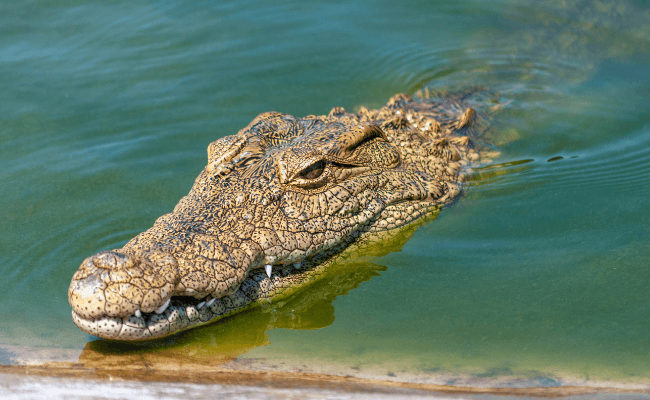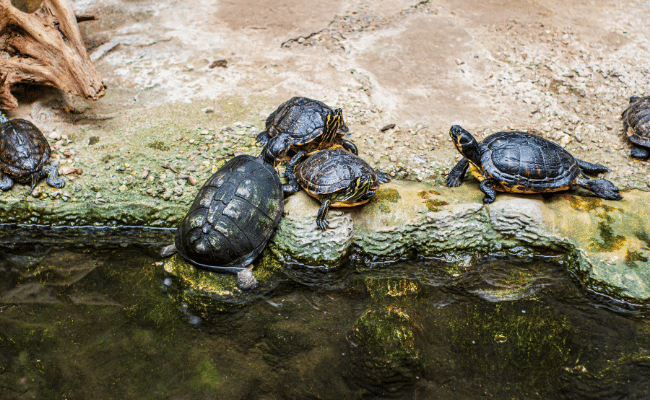
Table of Contents
Can snakes swim underwater?
Can snakes swim, Snakes can swim underwater, but their movement is not as smooth as fish. Snakes use the lateral undulation method of swimming to propel themselves through the water.
In this method, a snake lifts the majority of its body off the ground and curves into an “S” shape before moving its body in a wave-like motion from head to tail.
For a while, this method works well enough to push the snake through water, but eventually, it needs to resurface for air.
Some snakes can also swim with only their heads above water, allowing them to keep their bodies concealed from potential prey or predators while swimming from one location to another.
In some cases, a snake might even ambush its prey from underwater, striking out to grab the animal before dragging it back into the water.
Snakes are known for hiding in places where they can ambush their prey. This is why you should be careful if you decide to step into the pool after dark, or at least make sure you can see where your feet are stepping!
How fast can snakes swim?
It depends on the species of the snake.
For example, a [green tree python] is capable of swimming at 7 km per hour (4 mph), while an American [rattlesnake] can swim at 3 km/h (2 mph).
What determines the speed of a snake in water is its cross-sectional area and how streamlined it can make itself. A snake has to push more water than a similarly sized fish because its ventral scales are less hydrodynamic than the relatively smooth skin of a fish.
For example, sea snakes have very wide ventral scales that fold into a groove, creating a ridge. This allows them to swim very fast in the water and they often live most of their lives under the ocean’s surface.
Can snakes swim in saltwater?
Many people have question can snakes swim in saltwater?
Snakes are able to swim in saltwater just as well as they can swim in freshwater. This is because their lungs allow them to compensate for the differences that exist between fresh water and saltwater.
For example, if you have ever seen a snake come out of the water, you will notice that it shakes its skin to get dry. This is because the snake’s lungs are only able to absorb oxygen out of air, not water.
Therefore, if the snake were to stay in the water too long, it would drown.
However, many snakes have been known to stay submerged for up to 3 days without coming up for air. This is possible because when a snake dives into the water, its lungs expel all of the oxygen inside of them so that it can absorb the oxygen from the water instead.
Once the snake’s lung adapts to absorbing oxygen from water, then it can stay submerged for a long period of time.

Can snakes swim in cold water?
Snakes are reptiles which means they are cold-blooded. That means that their body temperature is regulated by the surrounding environment, in this case mostly by the water they are swimming in.
So, you can say that if it’s cold outside for him too, he won’t be able to swim. But of course, if he goes into colder areas he will have a harder time swimming.
But if it’s cold outside and the water is warmer, then the snake will be able to swim much longer. In colder water, you’ll mostly see them trying to get out because they can’t move much in such temperatures. But when the water warms up from 70°F / 20°C and higher they can swim quite happily.
According to the green tree python, a cold-blooded reptile, snakes can swim in cold water. In fact, they enjoy it quite a bit because it brings them warmth.
The green tree pythons have been recorded swimming up rivers and staying submerged for long periods of time.
When they surface from being underwater, their body temperature has increased and is significantly higher than when they were on land.
Can snakes swim in chlorine pool?
Can snakes swim in chlorine pool? frequently asked question. Snakes are very sensitive to their environment and will get sick if they get into a pool of chlorine. In fact, snakes die from the chlorine in swimming pools pretty regularly.
For people, swimming in chlorine is no big deal. The chemical is in the pool to kill bacteria and it does its job well.
But for anyone who wants to keep a pet snake (or any other reptile), you should never allow them into your pool if it has chlorine in it or there’s a strong chance that they will get sick and potentially die.
Snakes swimming in chlorine is a very common situation that costs many snakes their lives every year. If it’s not outright killing them, it can cause permanent damage to their lungs or other organs which will shorten the snake’s life span significantly.
In addition to endangering the health of your pet, you could also be charged with animal abuse if you are caught with your pet snake in a chlorinated swimming pool.
Can grass snakes swim?
Grass snakes are very effective swimmers. They have been recorded swimming across open expanses of water for distances greater than 120 meters.
It has also been observed that grass snakes don’t just swim across the surface, but they “fly” through the water – rising up and then skimming along the top few inches of the water.
Although they are not nearly as efficient in the water as an eel, their tolerance of cold water conditions seems to be extremely good. They have been known to survive being submerged in ice-cold water for over 24 hours.
Batesian mimicry is where a harmless species of animal mimic’s another more dangerous or harmful species, thereby gaining protection by “fooling” predators into thinking they are harmful.
A harmless snake’s ability to swim could be another example of this phenomenon, although more study is required to confirm whether this is the case.
Although I’ve not been able to find any documented cases of grass snakes attacking humans or pets, there have been some recorded cases of grass snakes biting people, although in most cases they did not cause any harm.

Can rattlesnakes swim?
Rattlesnakes are snakes found in different parts of the United States, Mexico, and Canada. These reptiles are known for their rattle on their tails.
They make this sound to warn people who come near them. Rattlesnakes are one of the most feared animals at home or even when you are traveling. There are many things we still don’t know about these animals and this is why we will be talking about can rattlesnakes swim?
The answer to the question of whether rattlesnakes can swim or not is yes. Rattlesnakes as well as most snakes have a good time in the water as they are able to hold their breath underwater for a long time.
However, rattlesnakes are not aquatic animals and can drown if they are in the water for too long. This is the reason why these reptiles usually stay away from water bodies. These snakes will only go near a river or lake when they need to drink water.
Rattlesnakes rarely go in the water unless they are forced to do so. These snakes have scales on their belly so they can easily glide in the water.
However, these reptiles spend most of their time on land because unlike other animals they cannot regulate their body temperature when in water.
Can corn snakes swim?
Corn snakes, Elaphe guttata, are indigenous to the southeastern United States. Natural habitats include forests, fields, rocky hillsides, and open grasslands.
Thus, it is logical for them to take shelter near water sources (i.e., ponds) during drought periods or when forest fires force them out of their homes. The question then arises: can corn snakes swim?
The answer is: yes and no. Corn snakes, like other snakes, are covered with scales that reduce their ability to swim efficiently, but they do have the ability to float and swim when in danger.
However, they are not adapted to an aquatic lifestyle. Their lack of specialized structures for swimming makes them avoid water whenever possible.
If forced to swim, they tend to stay near the surface and their movements resemble that of a worm more than a fish. When threatened by predators, including human beings, snakes will seek shelter wherever it is available.
A snake’s first choice of shelter is the abandoned burrow of another animal. If no burrow or other shelter is available, snakes will crawl into, under, or hide behind objects in their immediate environment.
While hiding, they are very vulnerable. To reduce this vulnerability, they attempt to find a dark area so they can better blend with their surroundings.






